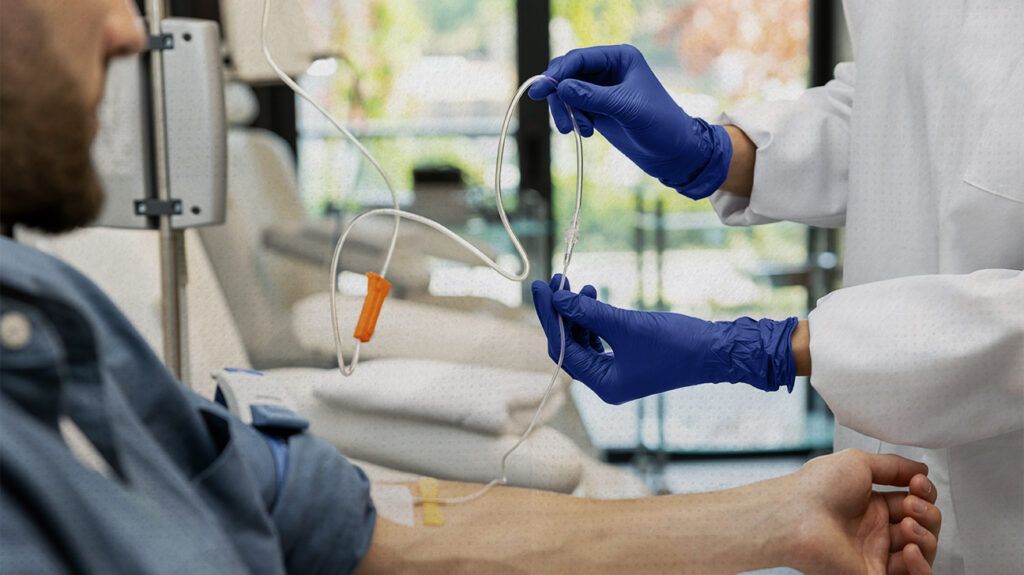Various treatments are available for lymphoma, including chemotherapy, radiation, immunotherapy, targeted therapy, or a bone marrow transplant.
A doctor or specialist can recommend which treatment is best for the type of lymphoma a person has. In some cases, doctors may recommend a combination of treatments.
Keep reading to learn more about treatment options for lymphoma.

Watchful waiting involves doctors closely
Some lymphomas are slow-growing and may not require treatment immediately. A person’s doctor may believe there is little benefit to commencing treatment right away.
However, this treatment approach requires regular visits to a healthcare professional. Treatment will begin if a doctor deems it necessary.
Learn more about watchful waiting.
Chemotherapy, which people often refer to as chemo, is a common treatment approach for lymphoma, especially non-Hodgkin’s lymphoma (NHL).
This treatment involves using strong drugs that kill cancer cells. Healthcare professionals administer chemo drugs as tablets or through an intravenous (IV) infusion, which is an injection a person receives into a vein over time.
Chemo can damage healthy cells and often causes side effects, some of which include nausea, mouth sores, and hair loss.
Doctors may prescribe chemo alone or in combination with other medications, such as steroids.
Learn more about chemotherapy for lymphoma.
Radiation therapy involves using high energy beams to destroy lymphoma cells.
A machine delivers these high-energy beams directly to a person’s lymph nodes. This process, called external beam radiation, is similar to getting an X-ray.
There are many cases in which a doctor
- to treat early lymphoma cases, usually stage 1 and 2
- to kill as many lymphoma cells as possible before a stem cell transplant
- as a palliative treatment to help ease symptoms of cancer that has spread to areas such as the brain or spinal cord
Treatment sessions usually take place 5 days a week for many weeks at a time. While radiation therapy is painless, it can cause side effects such as nausea, tiredness, diarrhea, and skin changes in the treated area.
Learn more about radiation therapy.
Immunotherapy boosts the body’s immune system to help it kill lymphoma cells or slow down their growth. Monoclonal antibodies attach to the surface of lymphocytes, a type of white bloods cell where lymphoma starts.
Rituximab is an example of a monoclonal antibody that works for NHL. Doctors can prescribe it alone or in combination with chemotherapy. Healthcare professionals usually administer the medication through an IV into the vein, and the infusion can take several hours.
Monoclonal antibodies
- serious infections
- issues with the nervous system
- a tumor flare, where the tumor may grow or cause more symptoms
- cytokine release syndrome (CRS), a life threatening condition
Sometimes, antibodies can have two targets. These antibodies are called bispecific T-cell engagers.
Learn more about immunotherapy.
This is also a type of immunotherapy, as it works to boost the body’s immune response to cancer cells. Doctors may recommend chimeric antigen receptor (CAR) T-cell therapy if other treatments have not been effective or if lymphoma returns.
CAR T-cell therapy involves removing T cells from a person’s blood and altering these cells in the lab so they have CAR receptors on their surface. These receptors can attach to lymphoma cells and destroy them. Healthcare professionals then return the altered T cells to the person’s blood.
The Food and Drug Administration (FDA)
Because CAR T-cell therapy has the potential to cause some serious side effects, such as CRS, this treatment is only available in medical centers where staff have special training in administering it.
Learn more about CAR T-cell therapy.
Targeted therapy involves using drugs to attack cancer cells and alter how they function. These drugs work differently from chemo.
Each type of drug
- BTK inhibitors
- EZH2 inhibitors
- proteasome inhibitors
- PI3K inhibitors
- nuclear export inhibitors
- histone deacetylase (HDAC) inhibitors
With most of these pills, the person takes them at intervals.
The side effects can vary depending on the exact type of drug a person takes. However, these medications commonly cause nausea and tiredness.
Learn more about targeted therapy.
A bone marrow transplant, which doctors also refer to as a stem cell transplant, is a major procedure. Before the transplant, a doctor administers high doses of chemo.
The transplant process involves collecting cells from the person before they undergo chemo, and putting them back at a later time. Sometimes, using the person’s own cells are unsuitable. In these cases, stem cells from a donor are necessary.
Not everyone can have a bone marrow transplant. For example, older individuals are less likely to be able to have one. A person can speak with an oncologist to check if this is a viable option.
Learn more about bone marrow transplants.
Is lymphoma very treatable?
Yes, lymphoma is very treatable. However, a person’s outlook can still depend on factors such as the type and severity of the lymphoma and how early they received a diagnosis.
Can you fully recover from lymphoma?
Treatment
Living with lymphoma, even after treatment, can be challenging. A person may wish to speak with a healthcare professional about the support options available.
What is the life expectancy of someone with lymphoma?
Life expectancy can vary based on the type of lymphoma a person has, the stage of the condition, and other factors.
Generally, the 5-year relative survival rate for a person with NHL is
However, these are only estimates. A person can speak with their oncologist about their outlook.
Cancer resources
To discover more evidence-based information and resources for cancer, visit our dedicated hub.
Treatment options for lymphoma include chemo, radiation therapy, immunotherapy, and targeted therapy. In some cases, a doctor may recommend a bone marrow transplant, which is a major procedure.
If a person has slow-growing lymphoma or the condition does not cause symptoms, a doctor may recommend deferring treatment until they deem it necessary.


